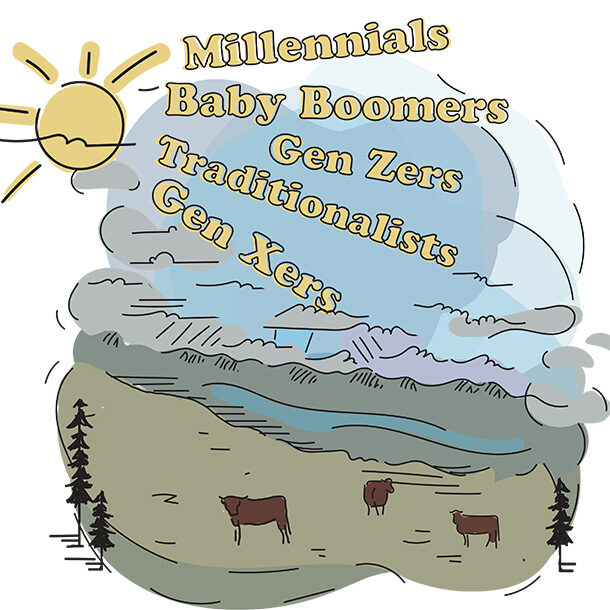Do you know you will not live forever? You may live all your days on the ranch, but the ranch will hopefully outlive you. Three-fourths of participants in a 2018 University of Idaho workshop on intergenerational transfer, or succession planning, did not plan on retiring. The survey did not explicitly ask if they would be happiest dying out on the ranch with their cows, but we believe that would have been the most common answer.
This article has two main objectives: to discuss succession planning with the generations that are starting to get into ranching and to discuss how to start the process of incorporating them into the ranch.
Too often, ranchers pass away suddenly without a succession plan in place. Not only did they not have a succession plan, but they often have not provided anyone with training on the management end, either.
If the worst were to happen, would your family members be able to answer the following questions:
- Do you have a line of credit? If so, how much is it for?
- How do we contact your banker, accountant and lawyer?
- What is the financial situation of the ranch and where are the records?
- What is your marketing plan?
- Do you lease or rent any land?
- What type of agreements or business entities do you have in place currently?
Based on these questions, would the next generation be able to take on your role as owner and operator if you weren’t there?
As we think about this new generation of ranchers, how do they differ from you? What life experiences have they encountered? What is their current life stage? All of this should be considered when it comes to communication and expectations.
Varying views
Our workplace is currently occupied by five identifiable and quite different generations: traditionalists, baby boomers, Gen Xers, millennials and Gen Zers. Traditionalists were those born before 1946. Baby boomers were born between 1946-1964. Gen Xers were born between 1965-1980. Millennials were born between 1981-1996. Gen Zers were born between 1997-2015. These separate generations are characterized by differences in work ethics, work-life balance, work assets, work liabilities, communication, feedback and mentoring.
Currently, mainly millennials and Gen Zers are entering the ranching business. Let’s talk about what they care about and how that might change the look of the ranching business.
Millennials are ambitious, multitaskers, goal-oriented and have a lot of tenacity. They focus on having a global perspective and enjoy networking. They value individuality and work-life balance. When it comes to continuing education and skill building, they believe newer skills produce less stressful situations and that education provides motivation. Millennials enjoy being challenged; strong, ethical leadership; being treated with respect; taking risks and continuing to learn new skills.
What does this mean in the ranching context? Millennial ranchers are not afraid of changing the business. They are not afraid to take risks such as changing the marketing model to direct sales to the consumer or using stock markets to hedge cattle. Since they love networking, Millennial ranchers might be more involved in commodity groups and other associations. Millennial ranchers like to seek mentorship and guidance from more experienced ranchers.
Generation Z is the newest of the working generations. They are entrepreneurial, tech experts, goal-oriented, inventive and self-aware. They value networks and innovation. Gen Zers are creative, non-conforming, positive, diverse and want to make a difference. A dream for Gen Zers would be to turn their passion into their work – doesn’t that sound like every rancher? They enjoy building relationships, pursuing creative outlets, finding professional development activities and using their technological skills. They dislike traditional work, conformity and being asked to do things without explanation.
As ranchers, Gen Zers are very creative in the way they view the business. If they are in ranching, it is because it is their passion. Most Gen Zers are interested in combating climate change and preserving the land. They will be more willing to incorporate soil health practices such as cover crops or exploring regenerative agriculture to serve their social compass.
Gen Zers tend to be more financially driven than most millennials and see profitability as a measure of success. They will want to put the ranch on the map with a social media presence or update computer systems to cellphone apps. They are masters of technology and hopefully quite capable of identifying opportunities and challenges within the ranch.
In with the new
As a part of your business, next-generation ranchers are going to want to try new things and incorporate new strategies into the ranch; this could be anxiety-inducing for older generations. These changes could result in success but could also be risky and expose the ranch to losses.
Incorporating new generations into the business could be difficult for many reasons. A major obstacle is frequently a lack of financial resources to support another generation. When it comes to financial concerns, being honest with the next generation about this topic is really important. One strategy might be for them to start building their own herd within the current generation’s own herd. Another strategy might be to use cow leases with the next generation.
It might be a good idea to ask the next generation to have some skin in the game before they incorporate any new strategies. Let them take out a Farm Service Agency (FSA) loan to finance their new enterprise. This would allow them to start being their own boss within a safe learning environment.
If the current rancher is not ready to incorporate the next generation because they are not sure of the next generation’s capabilities, a testing period is recommended in which they work alongside you. As they are going through the testing period, which could be anywhere from one to 10 years, they should be paid based on the value they are contributing to the ranch. “Sweat equity” is rarely ever paid back over time.
The testing phase would allow the older generation adequate time to show the next generation the ropes but would also permit the next generation to decide if the ranch is really what they want. The testing phase could mean being a hired hand for the first year, then slowly adding more responsibilities. The next step might be creating a marketing or farm plan. Transitioning the next generation into just one aspect of the business at a time could result in more harmony but could also cause impatience with the next generation.
No one knows what tomorrow will bring, but there are ways to plan. It is never too early to start the succession planning discussion with your family, but it can be too late. Some final words of advice from professor emeritus Ron Hanson from the University of Nebraska – Lincoln: “Hanging onto too much for too long can be a disaster.”









